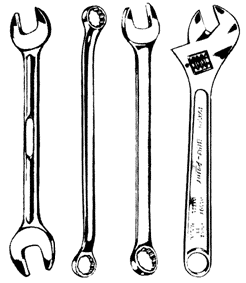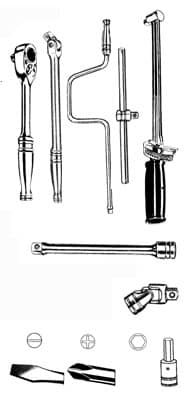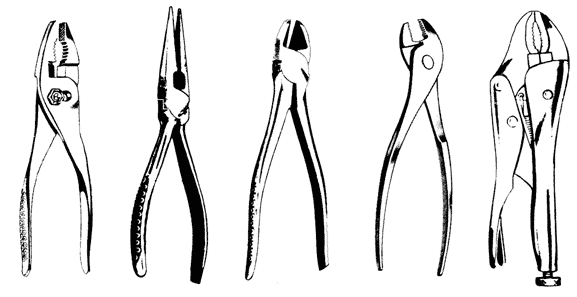Hand tools are the most popular and widely used tools in any industry. Because they do not require any external power source to operate they  can be used anywhere and everywhere. By selecting the right hand tool of the correct size a technician should be able to perform almost any task that is required.
can be used anywhere and everywhere. By selecting the right hand tool of the correct size a technician should be able to perform almost any task that is required.
Hand Wrenches
There are four (4) main types of hand wrenches available:
- Open-end Wrenches
- Box-end Wrenches
- Combination Wrenches
- Adjustable Wrenches
The open-end of any wrench is the easiest part of the wrench to use but not very effective for hard work because the wrench only grasps the fastener on two (2) sides and can easily slip, damaging the fastener and operator. The box-end of a wrench is far stronger because it holds the fastener on all sides. An adjustable wrench is similar to the open-end of a wrench but with one of the jaws being adjustable.
Socket Wrenches
Socket wrenches make it easier to remove and install fasteners. Socket wrench sets are available in three (3) main Drive sizes: 
- 1/4″ Drive
- 3/8″ Drive
- 1/2″ Drive
There are three main parts to using any socket wrench.
- The Socket
- The Handle
- An Extension or Adapter
Sockets are categorized in the follow way:
- Size – fastener head size to which the wrench fits (inches or mm)
- Drive – the size of socket wrench set it will fit (1/4”, 3/8”, 1/2”)
- Depth – the socket height or reach (shallow or deep)
- Type – for hand tool or air tool use (chrome or impact)
- 6 or 12 point – single or double hexagon
Handles
- Ratchet – attaches on to the socket providing leverage and a reversible ratcheting effect.
- L-handle – also referred to as a flex handle or a breaker bar. Provides additional leverage without any ratcheting movement.
- Speed handle – for fast removal and installation of a fastener.
- T-handle – for speed and even pressure.
- Torque wrench – insures correct fastener tension. Torque wrenches are available with dial gauges, flexible beams or click type. With the click type, the operator pre-sets the torque setting prior to tightening, then applies enough turning force until the wrench click is heard and/or felt.
Extensions and Adapters
- Extensions – installed in between the socket and the ratchet to provide a longer reach for ease of operation. Available in a variety of lengths.
- Universal – allows for flexible movement between the socket and the extension or ratchet. Could be an integral part of the socket (flex socket).
- Socket adapter – used to change the size of the drive when dealing with special situations.
Basic Drivers
The three (3) main types of drivers used in transportation are:
- Slot (flat)
- Phillips (cross)
- Allen (hexagon)
Each driver is usually available in a number of sizes. Slotted and Allen drivers are measured by the thickness of the blade or bit where as Phillips simply numbered 1 through 4.
Pliers and Cutters
Pliers are used to grasp and hold items, offering us a mechanical advantage. Cutters can also be used to hold items when used correctly besides  being able to cut through a variety of materials.
being able to cut through a variety of materials.
- General Purpose or Slip Joint pliers are used for most work. When equipped with a cutter they are often referred to as Linesman pliers.
- Needle Nose pliers are good for working in restricted areas and handling small or delicate parts.
- Side or Wire cutters are used for cutting tie straps, cotter pins and wires. They can also provide a superior grip when holding or pulling a piece in place.
- Battery pliers have jaws that are angled to help grasp fasteners that are either corroded or rusted.
- Locking or Vise-Grip pliers have a locking action that can hold parts in place.
Hammers and Mallets
Hammers and mallets are used to apply force when necessary to install certain parts or loosen parts that may be stuck or rusted in place.
- Ballpeen hammers are the most common hammer used in the shop
- Plastic hammers have a soft plastic face that should be used on only delicate materials such as aluminum.
- Rubber mallets can be used to install hub caps on vehicles so as not to damage the hub cap.

Great overview of essential hand tools! I especially appreciated the tips on choosing the right wrench sizes and the importance of having a good set of pliers. It’s always helpful to have a quick reference for DIY projects.